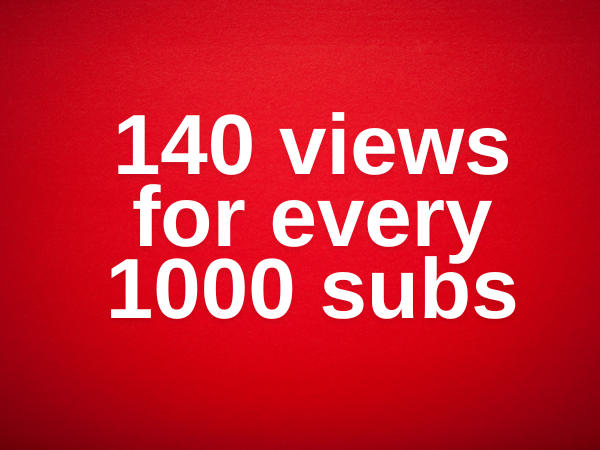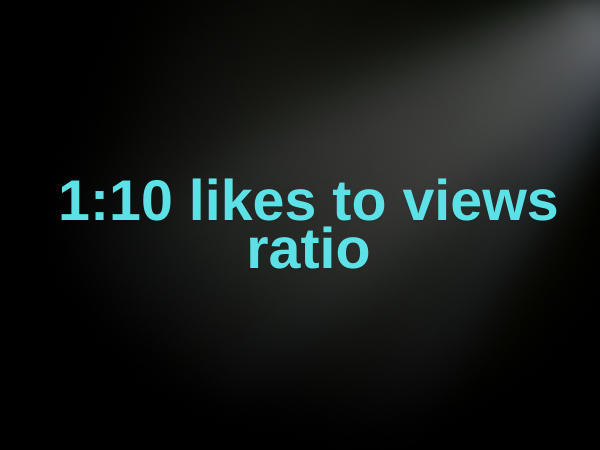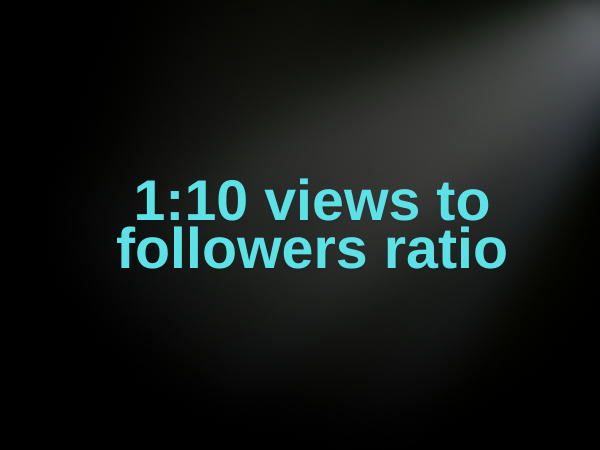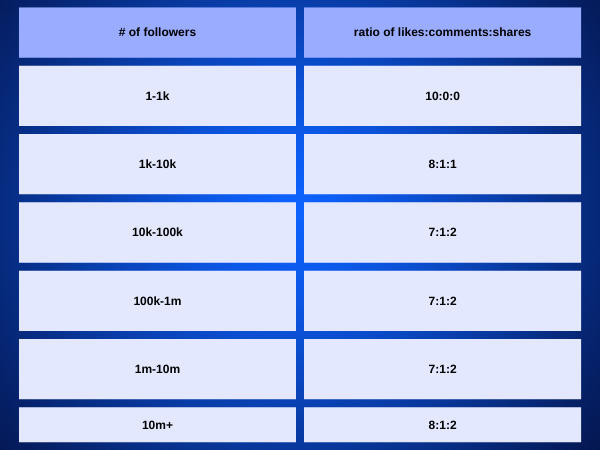It’s important to strike a balance between your social media goals and your content's current needs, especially when it comes to purchasing Likes, Views, Followers, and Subscribers.
So how many views, likes, followers, and subscribers should you purchase to keep things looking organic?
There is no one-size-fits all answer, but there are some key ratios to keep in mind while planning for success.
Key Points:

YouTube Likes To Views Ratio

The first metric ratio to keep in mind is YouTube Likes to Views.
In fact, this is the first thing viewers will notice when clicking your video, so it’s important to keep things looking natural.
As Likes determine a channel’s popularity, it’s important to maintain a ratio of approximately 4 likes per every 100 views - a 4% like to view ratio.
Likes inform a new viewer whether or not your content is worth sticking around for. If a video has 1,000 views but only 10 likes, it can look unnatural and unpopular. Aim for at least 4 likes per 100 views to keep things balanced.
YouTube Comments To Views Ratio

Another important metric ratio is Comments to Views. Comments show a first-time viewer that your content is engaging and worth talking about.
You should aim for at least 5 comments for every 1000 views, or a 0.05% comment to like ratio.
Be sure to keep the conversation going and engage with your audience when they comment.
Responding to comments shows your audience that you take the time to listen to their feedback, and allows you to create even better content in the future!
YouTube Views to Subscribers Ratio

Subscribers are the ultimate channel popularity metric.
The more subscribers you have, the more popular your channel is - it’s that simple!
When building your channel, it’s important to ensure that each of your videos reflects your channel’s overall popularity by maintaining a strong Views to Likes ratio.
For every 1,000 subscribers you have, you should have at least 140 views per video.
That means your Views to Subscribers ratio should be around 14% in order to achieve balance. Anything less than that and it may appear to an outside viewer that your subscribers just aren’t engaging with your content.
YouTube Watch Time & Retention
While outside viewers may not be aware of your retention rates, it’s an important inside metric to keep in mind for long-term success. Ensuring that your viewers are actually watching your videos is important and can affect your channel for better or worse.
 Instagram Followers to Following
Instagram Followers to Following

Looking to buy Instagram followers? The number of accounts you follow in relation to the number of accounts that are following you is a clear indicator of how you're earning your followers.
A common method to gaining followers fast on Instagram is by participating in "follow trains" - which means anyone you follow is following you.
If your follower to following count is almost the exact same number, this is a clear indicator that you're not truly earning your followers.
To give your profile the appearance of quality, make sure that you have more followers than accounts you are following. You can easily calculate this by determining your follower to following ratio.
Follow Ratio = Number of Followers ÷ Number of Accounts Followed
- If you have 10,000 followers and follow 1,000 accounts, your follow ratio is 10.
- A follow ratio of 1 means you follow the same number of accounts that follow you.
- A follow ratio greater than 1 means you have more accounts that follow you
- A follow ratio less than 1 means you follow more accounts than you have followers - this is what you should aim for.
Instagram Followers To Likes

When it comes to engagement, you want to make sure that at least 10% of your current follower count is engaging with your posts.
That means if you have 100 followers, you should be receiving an average of 10 likes per post.
Instagram Likes To Comments

Gaining Likes on Instagram is great, but comments are where the real quality lies. On average, you should aim to have at least 10% of the number of likes as comments.
That means if your post gains 10 likes, you should have at least 1 comment.
If it has 100 likes, you should have at least 10 comments.

TikTok Views To Likes

The average TikTok watch ratio is around 4% - that means for every 100 views a video receives, it earns 4 likes.
However, aiming for a 1:10 likes to views ratio will set your profile apart - that means for every 100 views a video receives, it earns 10 likes.
TikTok Followers To Views

Much like Views to Likes, aiming for a 1:10 ratio when it comes to views and followers is also ideal.
This means that for every 100 followers you have, you should have at least 10 views per post.

Facebook Page Followers To Post Interactions
When it comes to Facebook pages, the number of likes, comments, and shares that you should be receiving largely depends on the number of followers you have - and it's a lot lower than you might think!
The chart below shows how many interactions (likes, comments, and shares total) each post should have on average based on the number of followers your page has.

Facebook Post Likes To Comments To Shares
You can use the following chart to determine the ratio of likes, comments, and shares the average post on your Facebook page should have based on the number of followers your page currently has.

For example, if the ratio is 10:0:0, that means the post engagement should consist of mainly likes, rather than comments and shares. If the ratio is 8:1:2, this means that for every 8 Likes, there should be 1 Comment and 2 Shares. In other words, 80% of the engagement on the post should be Likes.




